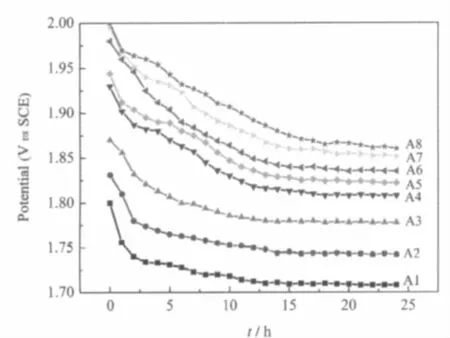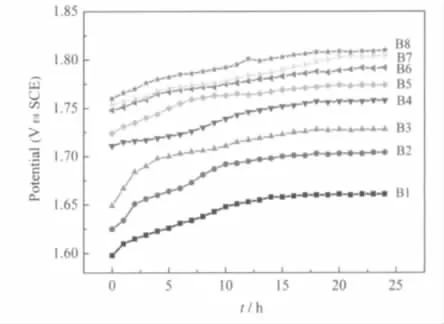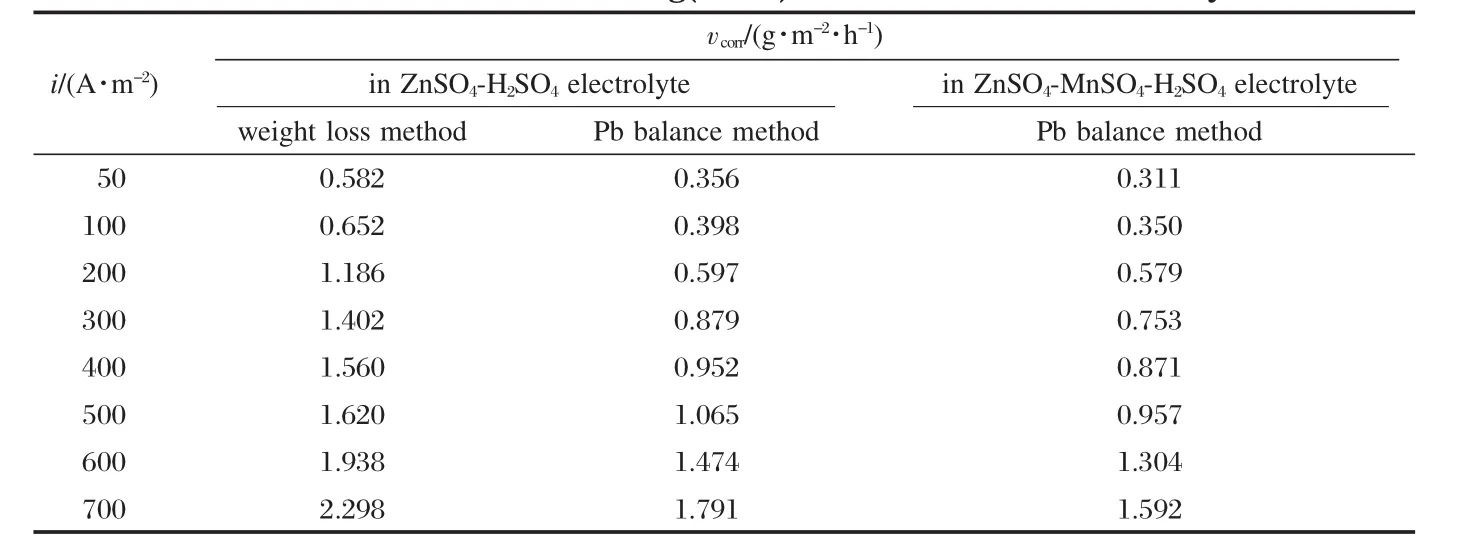Effect of Current Densities on the Electrochemical Behavior of a Flat Plate Pb-Ag Anode for Zinc Electrowinning
2012-11-06JIANGLiangXingZHONGShuiPingLAIYanQingXiaoJunHONGBoPENGHongJianZHOUXiangYangLIJieLIUYeXiang
JIANG Liang-Xing ZHONG Shui-Ping LAI Yan-Qing,* LÜ Xiao-Jun HONG BoPENG Hong-Jian ZHOU Xiang-Yang LI Jie LIU Ye-Xiang
(1School of Metallurgical Science and Engineering,Central South University,Changsha 410083,P.R.China;2Zijin Mining Group Co.,Ltd.,Shanghang 364200,Fujian Province,P.R.China)
Effect of Current Densities on the Electrochemical Behavior of a Flat Plate Pb-Ag Anode for Zinc Electrowinning
JIANG Liang-Xing1ZHONG Shui-Ping2LAI Yan-Qing1,*LÜ Xiao-Jun1HONG Bo1PENG Hong-Jian1ZHOU Xiang-Yang1LI Jie1LIU Ye-Xiang1
(1School of Metallurgical Science and Engineering,Central South University,Changsha 410083,P.R.China;2Zijin Mining Group Co.,Ltd.,Shanghang 364200,Fujian Province,P.R.China)
We studied the anodic potential,corrosion rate,and anodic passive layer of a flat plate Pb-Ag(0.8%(mass fraction,w)anode over a long period of polarization under different current densities.Additionally,the cathode current efficiency and quality of the zinc product in the ZnSO4-MnSO4-H2SO4electrolyte were also studied.The morphology of the anodic passive layer was characterized by scanning electron microscopy(SEM).The results show that the current density greatly affects the electrochemical behavior of the anode and the cathode during zinc electrowinning irrespective of Mn2+.With an increase in the current density,the anodic potential,corrosion rate,cathode current efficiency,and quantity of anode slime increased while the Pb content in the zinc product decreased.When the current density decreased from 500 to 200 A·m-2in the ZnSO4-MnSO4-H2SO4electrolyte,the stable anodic potential and the corrosion rate decreased by 64 mV and 40%,respectively.Under a lower current density,the anodic potential stabilizes more easily and the passive layer that forms on the surface of the anode is denser and it adheres better to the base body,which is advantageous for the reduction of the corrosion rate.Therefore,to reduce the anodic potential,corrosion rate,and the quantity of anode slime,increase the cathode current efficiency and quality of zinc product,we suggested that the ideal working condition for zinc electrowinning is a higher cathodic current density and lower anodic current density.
Zinc electrowinning;Current density;Pb-Ag anode;Anodic potential;Corrosion rate
As an important nonferrous metal,zinc is mainly produced by hydrometallurgical process.Zinc hydrometallurgy is typically divided into four processes as roasting,leaching,purifying,and electrowinning.In zinc electrowinning process,it involves the electrodeposition of zinc at the cathode and oxygen evolution at the anode.And the insoluble anode,mainly made of Pb-Ag (0.5%-1%(w))alloys,determines the energy consumed in the process as for the high oxygen evolution over-potential(about 860 mV)[1].Other problems of anode are the high corrosion rate of lead and subsequent incorporation of lead corrosion products in the cathode,which decrease the purity of zinc product.
In order to reduce the energy consumption,enhance the corrosion resistance,improve the product quality,and reduce the quantity of Ag required or even dispense with it,people have done much research work,which is mainly focused on lead-based alloy anode[2-9]and Ti-based coating anode(named DSA®)[10-15]. As for lead-based alloy anode,although many alloy anodes which can effectively reduce the quantity of Ag have been reported,only Pb-Co and Pb-Ag-Sn-Co anodes performed well in the perspective of reducing anodic potential.Regretfully,their complicated manufacturing conditions restricted their further commercial use.For Ti-based coating anodes,they are costly and can not avoid the passivation of Ti-base when anodized in H2SO4solution,so their further application is confined.Therefore,lead-based anode is still the anode that can be used industrially now and in the future[16].
In the zinc electrowinning industry,although the working current density is about 500 A·m-2,a pre-treatment of the anodes under low temperature and low current density is always performed before electrowinning.After that,a dense PbO2film is formed which can protect the anode from corrosion by H2SO4. Also,a novel porous Pb-Ag anode,which has a high specific surface area and then reduces the working current density,was reported[17-19].As the porous anode is always operated near pretreatment conditions,the anodic potential and corrosion rate are much lower than flat plate anode at the same apparent current densities.Therefore,current density may have great effect on the electrochemical behavior of anode.Although there have been some empirical analyses about the effect of current density on anodic potential,corrosion rate,the passive layer structure, current efficiency,and quality of Zn[3,20-23],no systematic study has been reported.
In order to further understand the electrochemical properties of porous anode and provide theoretical data of the effect of current density on anodic electrochemical behavior,the anodic potential,corrosion rate,and structure of passive layer of flat plate Pb-Ag anode were studied systematically under different current densities in electrolyte of ZnSO4-H2SO4and ZnSO4-MnSO4-H2SO4,respectively.Furthermore,in ZnSO4-MnSO4-H2SO4electrolyte,the quantity of anode slime,cathode current efficiency,and quality of zinc product were studied.
1 Experimental
The Pb-Ag alloy was cut into cubic samples(10 mm×10 mm× 5 mm)and sealed by epoxy resin with 1 cm2surface exposed to the air.Before electrochemical and corrosion test,the electrodes havetobedegreasedby alkali and ethanol and washed by doubledistilled water.
As shown in Table 1,the experiments were divided into two groups,in which group A was carried out in the electrolyte of ZnSO4-H2SO4,and group B was in the electrolyte of ZnSO4-MnSO4-H2SO4.All the reagents used were AR grade.
1.1 Anodic potential
The anodic potential was tested by chronopotentiometry(CP) under different current densities(raging from 50 to 700 A·m-2). All the tests were carried out in a glass three-electrode system. The anodic potential was measured against Hg/Hg2Cl2(SCE) reference electrode(If there is no particular demonstration,the potential is relative to the SCE.).All electrolytes were prepared with analytically pure grade chemicals and double-distilled water,and the volume of electrolytes is 1000 mL in every test to keep the ions variation comparable.The temperature was kept constant((37.0±0.5)℃)by means of an HH-1 thermostat.
1.2 Corrosion rate
The corrosion of the anode is caused by the dissolution of lead into electrolyte.Some of the dissolved lead co-deposits with zinc on the cathode,while some inter-mixes with anode slime.Two ways were used to test the corrosion rate of anodes. One is weight loss method.The other is Pb balance method which uses the Pb content change in the electrolyte and Zn to determine the corrosion rate.Atomic absorption spectrophotometer(Hitachi Japan,Z-5000)was used to test the Pb2+concentration change in the solution both before and after anodic polarization.Quartzspectrograph(ИСΠ-30)wasusedtotestPbcontent in Zn.The corrosion rate(vcorr)measured by Pb balance method was calculated by the following equation:

where C is the concentration of Pb2+in electrolyte(g·L-1),V is the electrolyte volume(L),w is the mass percentage of Pb in zincproduct(%),m is the mass of zinc product(g),S is the apparent area of anode(m2),and t is the polarization time(h).

Table 1 Experimental conditions
1.3 Microstructure of passive layer
After polarization for 72 h,the anode was removed from electrolyte,washed with double-distilled water and dried immediately.Then,the microstructure of the passive layer was observed by scanning electron microscopy(JEOL Japan,JSM-6360LV).
2 Results and discussion
2.1 Anodic potential
Fig.1 shows the Galvanostatic polarization of flat Pb-Ag (0.8%)anode in the electrolyte of pure ZnSO4-H2SO4at different current densities.It can be seen from Fig.1 that the anodic potential of flat plate anode is obviously different under different current densities and it increases with the increase of current density.When the current density increases from 100 to 500 A· m-2,the stable anodic potential increases about 100 mV,which is from 1.742 to 1.835 V.But the increasing speed is not the same,when the current density is above 300 A·m-2,the effect of current density on anodic potential is less.It can also be found that the anodic potential decreases rapidly at the beginning and then stabilizes gradually.This is because a nonconductive PbSO4layer is firstly generated on the fresh anode surface,and then the current density and potential of the uncovered surface will increase.Due to high oxygen evolution potential on the surface of Pb,the generated PbSO4and the uncovered Pb will transform into PbO2covering the anode surface and then the reaction of oxygen evolution will take place on the surface[24].When the reaction reaches balance,the anode potential will stabilize.But we can also find that the time needed to reach stable is different. The time is about 10 h when the current density is less than 200 A·m-2.While the current density is greater than 200 A·m-2,the time needed is about 15 h.Although the anode potential is difficult to achieve stabilization,we can conclude that the anode surface is easier to stabilize under lower current density.

Fig.1 Galvanostatic polarization of flat Pb-Ag(0.8%)anode in the electrolyte of pure ZnSO4-H2SO4at different current densitiesi/(A·m-2):(A1)50,(A2)100,(A3)200,(A4)300,(A5)400,(A6)500, (A7)600,(A8)700

Fig.2 Galvanostatic polarization of Pb-Ag(0.8%)anode in the electrolyte of ZnSO4-MnSO4-H2SO4at different current densitiesi/(A·m-2):(B1)50,(B2)100,(B3)200,(B4)300,(B5)400,(B6)500, (B7)600,(B8)700
In the electrolyte of ZnSO4-MnSO4-H2SO4,we have the similar results(Fig.2)that further confirm the conclusion above.The only difference is that the anodic potential firstly increases and then stabilizes under a specific current density.
According to the data in Fig.1 and Fig.2,we obtained the Tafel curves of flat plate anode as shown in Fig.3.We can see that the Tafel curves are parallel straight lines(Tafel slopes are 0.13 V/decade),which indicates that the oxygen evolution mechanism is the same both in the electrolyte of ZnSO4-H2SO4and ZnSO4-MnSO4-H2SO4.The existence of Mn2+in electrolyte has no effect on it.Meanwhile,the difference between the parameter a in different electrolytes is 52 mV,the depolarization effect of Mn2+is obvious.Under the current density of 500 A·m-2,the anodic potential with and without Mn2+in electrolyte is 1.792 and 1.835 V,respectively.
2.2 Corrosion rate
The corrosion rates of the traditional flat plate anode under different current densities were measured by both the anode weight loss method and the Pb balance method,and the results are shown in Table 2.

Fig.3 Tafel curves of flat plate anode

Table 2 Corrosion rate of Pb-Ag(0.8%)anode in different electrolytes
It can be found that the corrosion rate measured by anode weight loss method is a little bigger than that by Pb balance method.For example,when the current density is 500 A·m-2, the corrosion rates measured by the anode weight loss method and the Pb balance method are 1.620 and 1.065 g·m-2·h-1,respectively.However,the variation tendency of corrosion rate measured by the two methods is the same,that is,the corrosion rate increases with the increase of current density.
From Table 2 we can also find that Mn2+does not change the variation tendency of corrosion rate,that is,the corrosion rate increases with the increase of current density.For example, when the current density decreases from 500 to 100 A·m-2,the anodic corrosion rate decreases from 0.957 to 0.350 g·m-2·h-1. Under the same current density,the existence of Mn2+can reduce the corrosion rate of anode remarkably,which is in line with the literature search and industrial practice[20,25].This is because Mn2+was oxidized to permanganic acid on the anode through the following equation:
4MnSO4+6H2O+5O2=4HMnO4+4H2SO4(2) Then,the permanganic acid in the solution reacts with Mn2+to form MnO2according to the following equation:
2HMnO4+3MnSO4+2H2O=5MnO2+3H2SO4(3) A part of MnO2deposits to the bottom of electrolytic tank which is usually recycled and used in the leaching system.The rest of MnO2adheres to the anode and forms a composite protective layer on the anode surface with PbO2and then the corrosion rate is reduced.At the same time,MnO2is well known as oxygen evolution catalyst,the Pb/PbO2-MnO2composite anode formed in ZnSO4-MnSO4-H2SO4electrolyte can reduce the anodic potential.This phenomenon is called the depolarization effect and Fig.3 is the evidence.
2.3 Passive layer and anode slime
In order to observe the effects of current density on the morphology of passive layer,the surface morphology of flat plate anode was observed by SEM after 72 h galvanostatic polarization in electrolytes of ZnSO4-H2SO4and ZnSO4-MnSO4-H2SO4under current densities of 50,100,and 500 A·m-2,respectively. The relevant pictures are shown in Fig.4 and Fig.5.
As can be seen from Fig.4,the surface morphologies change a lot with the change of current density.When the current density is 50 A·m-2,dense surface morphology is observed and the passive layer is well combined with the base body after 72 h polarization.When the current density increases to 500 A·m-2,the anode surface morphology becomes loose as shown in Fig.4c. Combining with the corrosion rate,we can conclude that low current density can produce dense PbO2coating on the anode surface which is beneficial for protecting the anode from corrosion,while high current density will produce loose oxidized layer and then increase the corrosion rate.
As shown in Fig.5,the surface morphologies also change a lot with the change of current density in ZnSO4-MnSO4-H2SO4electrolyte.Under the current density of 50 A·m-2,the particles on the anode surface are coarse and well combined with the base body.When the current density is 500 A·m-2,the particles are fine,loose,and not well combined with the base body.The surface morphology for the current density of 100 A·m-2is between them.Comparing Fig.4 and Fig.5,it can be found that Mn2+has significant influence on the microstructure of passive layer.

Fig.4 SEM images of Pb-Ag(0.8%)anode after 72 h polarization in the electrolyte of pure ZnSO4-H2SO4at different current densitiesi/(A·m-2):(a)50,(b)100,(c)500

Fig.5 SEM images of Pb-Ag(0.8%)anode after 72 h polarization in the electrolyte of ZnSO4-MnSO4-H2SO4at different current densitiesi/(A·m-2):(a)50,(b)100,(c)500

Table 3 Change of Mn2+content in the electrolyte of ZnSO4-MnSO4-H2SO4with current density
As current density has large influence on the anode morphology,it is predictable that current density will have some influence on the quantity of anode slime.Because of the small anode surface,limited polarization time and unable to collect the anode slime,the variation of Mn2+concentration before and after electrolysis was used to determine the formation of anode slime(the main component of the anode slime is manganese dioxide), and the results are shown in Table 3.
From Table 3 it can be found that when the current density is low(such as 50 A·m-2),the Mn2+content is almost not changed after 24 h polarization(from 4.000 to 3.969 g·L-1).With the increase of current density,the Mn2+content after electrolysis is rapidly decreased.When the current density reaches to 500 A· m-2,the Mn2+content is only left to 3.570 g·L-1.In other words, with the increase of current density,the Mn2+diluting phenomenon becomes more severe,which means that the quantity of anode slime increases.
2.4 Current efficiency and Zn product
Table 4 lists the current efficiency and quality of Zn for the Pb-Ag(0.8%)anode after 24 h galvanostatic polarization in the electrolyte of ZnSO4-MnSO4-H2SO4.
It can be seen from Table 4 that the current efficiency is gradually increased with the increase of current density.When current density is above 400 A·m-2,the current efficiency is all above 90%,and the maximum value is 93.80%.As we know that Zn lies considerably above H2in the electrochemical series, the evolution of H2should be easier than that of Zn.But the evolution overpotential of H2is high on zinc deposits and Al electrode used in zinc electrowinning,which causes the evolution potential of H2to shift negatively and become lower thanthe deposition potential of Zn.With the increase of current density,the H2evolution overpotential increases,which is propitious to the deposition of Zn and the increase of current efficiency.But when high current density is adopted,high concentration of Zn and low temperature electrolysis should be guaranteed.So the current density is usually controlled at around 500 A·m-2in industry.

Table 4 Current efficiency and quality of Zn in the electrolyte of ZnSO4-MnSO4-H2SO4under different current densities
Table 4 also lists the change of Pb content in cathode zinc under different current densities.When the current density changes from 50 to 600 A·m-2,the Pb content decreases from 0.0350%to 0.0061%.It can be concluded that the increase of current density can be beneficial for improving Zn quality.The reason is that the precipitate speed of impurity is not only relative with precipitate potential but also relative with diffusion speed.When the impurity concentration reaches a certain low degree,the ionic extreme surface current will be in direct proportion of diffusion coefficient and the precipitation speed of a certain ion will be determined by its extreme current density. The impurity content in the cathode zinc is determined by the following equation:

where idis the extreme current density(A·m-2),MPband MZnare the atomic weights of Pb and Zn(g·mol-1),respectively,η is the current efficiency(%),and i is the current density(A·m-2).It can be concluded that if the current density increases,the Pb content in the cathode Zn will decrease and the quality of output will be improved.
3 Conclusions
(1)The anodic potential increases with the increase of current density.When current density decreases from 500 to 100 A·m-2, the anodic potential(vs SCE)decreases from 1.835 to 1.742 V in the ZnSO4-H2SO4electrolyte.
(2)The corrosion rate decreases with the decrease of current density.When current density decreases from 500 to 100 A·m-2, the corrosion rate decreases from 1.620 to 0.652 g·m-2·h-1in the pure ZnSO4-H2SO4electrolyte.
(3)With the increase of current density,the Mn2+diluting phenomenon becomes more severe.When the current density is low,the Mn2+content is almost not changed after 24 h polarization.With the increase of current density,the Mn2+content decreases rapidly after polarization.
(4)The anodic passive layer under different current densities presented the different microstructures.When the current density is 50 A·m-2,dense surface morphology is observed and the passive layer is well combined with the base body after 72 h polarization.When the current density is increased to 500 A·m-2, the anode surface morphology will become loose.
In a word,the decrease of the anodic potential,corrosion rate, and quantity of anode slime can be realized by reducing the current density.However,that will decrease the cathodic current efficiency and the quality of zinc.If the anode can be made porous,the conductive area of anode would be increased a lot and the anodic current density would be reduced without changing the current,so energy would be saved.
1 Petrova,M.;Stefanov,Y.;Noncheva,Z.;Dobrev,T.;Rashkov,S. British Corrosion Journal,1999,34(3):198
2 Stefanov,Y.;Dobrev,T.Transactions of the Institute of Metal
Finishing,2005,83(6):296
3 Ivanov,I.;Stefanov,Y.;Noncheva,Z.;Petrova,M.;Dobrev,T.; Mirkova,L.;Vermeersch,R.;Demaerel,J.P.Hydrometallurgy, 2000,57:109
4 Rashkov,S.;Dobrev,T.;Noncheva,Z.;Stefanov,Y.;Rashkova, B.;Petrova,M.Hydrometallurgy,1999,52:223
5 Newnham,R.H.Journal of Applied Electrochemistry,1992,22: 116
6 Zhong,S.P.;Lai,Y.Q.;Jiang,L.X.;Lü,X.J.;Chen,P.R.;Li,J.; Liu,Y.X.Journal of Central South University of Technology, 2009,16(2):236
7 Lupi,C.;Pilone,D.Hydrometallurgy,1997,44:347
8 Rashkov,S.;Stefanov,Y.;Noncheva,Z.;Petrova,M.;Dobrev,T.; Kunchev,N.;Petrov,D.;Vlaev,S.T.;Mihnev,V.;Zarev,S.; Georgieva,L.;Buttinelli,D.Hydrometallurgy,1996,40:319
9 Camurri,C.P.;López,M.J.;Pagliero,A.N.;Vergara,F.G. Materials Characterization,2001,47:105
10 Li,B.S.;Lin,A.;Gan,F.X.Trans.Nonferrous Met.Soc.China, 2006,16(5):1193
11 Hu,J.M.;Zhang,J.Q.;Cao,C.N.International Journal of Hydrogen Energy,2004,29(8):791
12 Stefanov,Y.;Dobrev,T.Transactions of the Institute of Metal Finishing,2005,83(6):291
13 Cattarin,S.;Guerriero,P.;Musiani,M.Electrochimica Acta,2001, 46:4229
14 Shrivastava,P.;Moats,M.S.Journal of the Electrochemical Society,2008,155(7):E101
15 de Mussy,J.P.G.;MacPherson,J.V.;Delplancke,J.L. Electrochimica Acta,2003,48:1131
16 Felder,A.;Prengaman R.D.JOM,2006,58(10):28
17 Zhong,S.P.;Lai,Y.Q.;Jiang,L.X.;Lü,X.J.;Chen,P.R.;Li,J.; Liu,Y.X.Journal of Central South University of Technology, 2008,15(6):757
18 Lai,Y.Q.;Jiang,L.X.;Li,J.;Zhong,S.P.;Lü,X.J.;Peng,H.J.; Liu,Y.X.Hydrometallurgy,2010,102:73
19 Lai,Y.Q.;Jiang,L.X.;Li,J.;Zhong,S.P.;Lü,X.J.;Peng,H.J.; Liu,Y.X.Hydrometallurgy,2010,102:81
20 Peng,R.Q.;Ren,H.J.;Zhang,X.P.Metallurgy of lead and zinc. Beijing:Science Press,2003:413 [彭容秋,任鸿九,张训鹏.铅锌冶金学.北京:科学出版社,2003:413]
21 Mei,G.G.;Wang,R.D.;Zhou,J.Y.;Wang,H.Hyrometallurgy of zinc.Changsha:Central South University Press,2001:340-402 [梅光贵,王德润,周敬元,王 辉.湿法炼锌学,长沙:中南大学出版社,2001:340-402]
22 Zhang,Y.P.Hydrometallurgy of China,2001,20(4):169 [张玉萍.湿法冶金,2001,20(4):169]
23 Ivanov,I.;Stefanov,Y.;Noncheva,Z.;Petrova,M.;Dobrev,T.; Mirkova,L.;Vermeersch,R.;Demaerel,J.P.Hydrometallurgy, 2000,57:125
24 Nguyen,T.;Atrens,A.Hydrometallurgy,2009,96:14
25 Pu,Y.;O′Keefe,T.J.Journal of the Electrochemical Society, 2002,149(5):558
电流密度对锌电积用Pb-Ag平板阳极电化学行为的影响
蒋良兴1衷水平2赖延清1,*吕晓军1洪 波1彭红建1周向阳1李 劼1刘业翔1
(1中南大学冶金科学与工程学院,长沙 410083;2紫金矿业集团股份有限公司,福建上杭 364200)
研究了在不同电流密度下进行长时间极化后Pb-Ag(0.8%(质量分数,w))平板阳极的阳极电位、腐蚀率及阳极钝化膜.同时,也研究了该阳极在ZnSO4-MnSO4-H2SO4电解液中的阴极电流效率和阴极锌品质.阳极钝化膜的表面形貌用扫描电镜(SEM)进行观测.实验结果表明,不管电解液中是否存在Mn2+,电流密度对阳极和阴极的电化学行为都产生了显著的影响.随着电流密度的升高,阳极电位、腐蚀率、阴极电流效率和阳极泥生成量也增加,而阴极锌中的Pb含量则减少.当电流密度从500 A·m-2降到200 A·m-2时,阳极在ZnSO4-MnSO4-H2SO4电解液中的稳定电位和腐蚀率分别减少64 mV和40%.此外,在比较低的电流密度下,阳极电位更容易稳定,阳极表面生成的钝化膜更加致密并与基体结合牢固,这些都有利于降低阳极腐蚀率.为了降低阳极电位、减小阳极腐蚀率及阳极泥生成量并提高阴极电流效率和阳极锌品质,锌电积的理想工作条件是较低的阳极电流密度和较高的阴极电流密度.
锌电积;电流密度;Pb-Ag阳极;阳极电位;腐蚀率
O646
Received:April 12,2010;Revised:May 31,2010;Published on Web:July 27,2010.
*Corresponding author.Email:csulightmetals@126.com;Tel:+86-731-88830649.
The project was supported by the National Natural Science Foundation of China(50954006).
国家自然科学基金(50954006)资助项目
ⒸEditorial office of Acta Physico-Chimica Sinica
猜你喜欢
杂志排行
物理化学学报的其它文章
- Adsorption Mechanism of Nonylphenol Polyethoxylate onto Hypercrosslinked Resins
- Coexistence of Oligonucleotide/Single-Chained Cationic Surfactant Vesicles with Precipitates
- Influence of Calcination Temperature on the Performance of Cu-Al-Ba Catalyst for Hydrogenation of Esters to Alcohols
- Novel Synthesis of Mesoporous Nanocrystalline Zirconia
- Fluorescence Behavior of Biphenyl Containing Side-Chain Liquid Crystalline Polyacetylene with Various Lengths of Spacers
- Numerical Analysis of the Effect of Carbon Monoxide Addition on Soot Formation in an Acetylene/Air Premixed Flame
